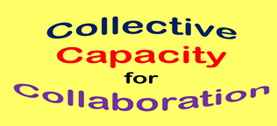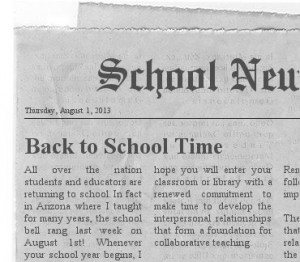 Sue Kimmel posted recently about finding ways to connect and collaborate with teachers using the Common Core Math Standards and literacy. This week I want to encourage reaching out to make connections around science initiatives, too, by looking at citizen science.
Sue Kimmel posted recently about finding ways to connect and collaborate with teachers using the Common Core Math Standards and literacy. This week I want to encourage reaching out to make connections around science initiatives, too, by looking at citizen science.
Citizen scientists ignite a passion for science and inquiry through participation in authentic projects that actively make a difference in scientific knowledge on large and small scales. With the current emphasis on science, technology, engineering, and mathematics (STEM) in many school districts across the nation, the citizen scientist collaborative model for collective inquiry, gathering and analyzing data, and problem solving can be used to generate enthusiasm and curiosity in science classrooms.
Here is an opportunity for teacher librarians to become acquainted with the Common Core ELA Science Standards 6-12, and the Next Generation Science Standards, and to bring some fresh ideas and resources for developing curriculum units with other classroom teachers.
As an instructional partner, and co-teacher, we have to continue to build our teaching toolkit with pedagogy and content knowledge. For students to become citizen scientists in their schools and communities, teacher librarians and teachers collaborate to design meaningful learning opportunities that engage curious minds, require action and reflection, and help solve real world problems. Or, you could also get your students interested in a citizen science club that could have a physical and virtual presence in your library media center!
What is “citizen science?” you might ask. How does technology play role in the collective capacity of amateur scientists all over the world, or in your own community? How can you develop a unit of study that replicates or enjoins some of the authentic work that is done by citizen scientists?
Here are a few ideas to get the ball rolling with both teachers and students:
Recommended reading:
- Citizen Scientists by Loree Griffin Burns presents an approachable overview about the impact of citizen science for young people. It’s a great introduction to some of the current projects around the world and shows how global citizenship is enhanced by making connections and contributions by individuals. As an example of narrative non-fiction, is can also serve as a model for Common Core Reading and Writing Standards.
Edutopia website has a couple of related blog posts:
- Eris Brunsell, Assistant Professor of Science Education at University of Wisconsin, explains what citizen science can do to fire up science inquiry in his post, “A Primer on Citizen Science.” (Oct 13, 2010). http://www.edutopia.org/blog/citizen-science-eric-brunsell
- Mark Phillips, an education blogger and teacher posted, “Teaching and the Environmental Crisis: Resources and Models ,” (April 17, 2013). It offers examples of how teachers have incorporated citizen science into their science curriculum. There are live links to follow. http://www.edutopia.org/blog/teaching-environmental-crisis-resources-models-mark-phillips
Youtube videos that present examples of authentic science inquiry:
- “This Thing Called Science Part 6: Citizen Science,” quick 3 minute overview of the history of science that holds a few surprises. http://www.youtube.com/watch?v=N6eN3Pll4U8
- “Digital Fishing on Citizen Science Cruise,” shares the educational program of the Crystal Cove Alliance in Newport Beach (CA) that immerses Students in the science of marine protected area management.http://www.youtube.com /watch?v=u6m2tqZMD3s
- “Technology creates Citizen Scientists” relates the critical role that technology plays in allowing citizen scientists to help solve real world problems at local and global levels. http://www.youtube.com/watch?v=81hhecI0p5k
Websites:
- “Scientific American: Citizen Science” has links to a wide variety of ongoing projects that are open for citizen scientist participation. Some looks to be adaptable for all ages of students. http://www.scientificamerican.com/citizen-science/
- “Scistarter: Science We Can Do Together” offers many projects and ideas for scientific inquiry and citizen scientists. http://www.scistarter.com/
Calling All Citizen Scientists!
I’m sure there are many opportunities in your local school and community for getting your student citizen scientists involved in helping to solve problems. Catch the STEM wave that is a natural fit for your library program!
References:
Burns, Loree Griffin (2012). Citizen scientists. NY: Square Fish. http://us.macmillan.com/citizenscientists/LoreeGriffinBurns
Brunsell, Eric. (2010). A primer on citizen science. Edutopia (2010, Oct.13). Weblog. Retrieved from: http://www.edutopia.org/blog/citizen-science-eric-brunsell. .
Common core Initiative: English Language Arts: Science and Technical Standards (2011). Website. Retrieved from: http://www.corestandards.org/ELA-Literacy/RST/9-10. .
Digital fishing on citizen science cruise. (2012, Sep. 25) Newport Beach, CA: Crystal Cove Alliance. Video. Retrieved from: http://www.youtube.com/watch?v=u6m2tqZMD3s.
Next Generation Science Standards. (2013). Website. Retrieved from: http://www.nextgenscience.org/.
Phillips, Mark. (2013, April 17). Teaching and the environmental crisis: resources and models. Edutopia . Weblog. Retrieved from: http://www.edutopia.org/blog/teaching-environmental-crisis-resources-models-mark-phillips.
Scientific American: Citizen Science. Website. Retrieved from: http://www.scientificamerican.com/citizen-science/.
Scistarter. Website. Retrieved from: http://www.scistarter.com/.
Technology creates Citizen Scientists. (2012, Aug. 16) California Academy of Science. Video. Retrieved from: http://www.youtube.com/watch?v=81hhecI0p5k.
This thing called science part 6: Citizen science. (2013, May 23). TechNyouvids. Video. Retrieved from: http://www.youtube.com/watch?v=N6eN3Pll4U8.
Microsift clipart.


